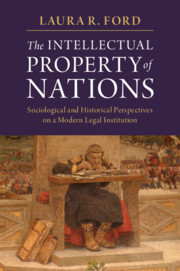 The Intellectual Property of Nations
The Intellectual Property of Nations Book contents
- The Intellectual Property of Nations
- The Intellectual Property of Nations
- Copyright page
- Contents
- Preface and Acknowledgments
- Introduction
- 1 Legal Institutions and Social Power
- 2 Legal Orders and Social Performance
- 3 Instruments of Legal Power in the Roman Republic
- 4 Semantic Legal Ordering
- 5 Cultural Transformations
- 6 Privileges and Immunities in a Sacramentalizing Order
- 7 Administrative Kingship and Covenantal Bonds
- 8 Intellectual Property in a Nationalizing Order
- 9 Cultural Transformations
- 10 Semantic Legal Ordering
- 11 Instruments of Legal Power in the American Republic
- 12 Legal Orders and Social Performance
- Conclusion The Intellectual Property of Nations
- Index
6 - Privileges and Immunities in a Sacramentalizing Order
Published online by Cambridge University Press: 04 June 2021
- The Intellectual Property of Nations
- The Intellectual Property of Nations
- Copyright page
- Contents
- Preface and Acknowledgments
- Introduction
- 1 Legal Institutions and Social Power
- 2 Legal Orders and Social Performance
- 3 Instruments of Legal Power in the Roman Republic
- 4 Semantic Legal Ordering
- 5 Cultural Transformations
- 6 Privileges and Immunities in a Sacramentalizing Order
- 7 Administrative Kingship and Covenantal Bonds
- 8 Intellectual Property in a Nationalizing Order
- 9 Cultural Transformations
- 10 Semantic Legal Ordering
- 11 Instruments of Legal Power in the American Republic
- 12 Legal Orders and Social Performance
- Conclusion The Intellectual Property of Nations
- Index
Summary
This chapter outlines a "feudal transformation" in medieval Europe, in which originality and creativity became activities to be protected and encouraged through grants of legal privileges. A Venetian statute that many have seen as Europe's first patent law is here placed in the context of legal and religious reforms overseen by Carolingian bishops and rulers. The trajectory of these reforms is traced through the development of medieval universities and legal education, which are linked, in turn, to an idealizing social vision of law as a morally binding force, drawing people together into communities through legal promises and oaths. With the birth of the European legal profession, Roman and Biblical legal traditions are synthesized into the legal foundation for medieval city-states, guilds, and universities, together with the prebend system that provides material support for clerics of various kinds. In the medieval city-state of Venice, these legal traditions become the basis for a transformation in legal privileges, emphasizing the value of novelty and creativity for legal communities and providing early precursors for later patent and copyright law.
- Type
- Chapter
- Information
- The Intellectual Property of NationsSociological and Historical Perspectives on a Modern Legal Institution, pp. 176 - 206Publisher: Cambridge University PressPrint publication year: 2021
